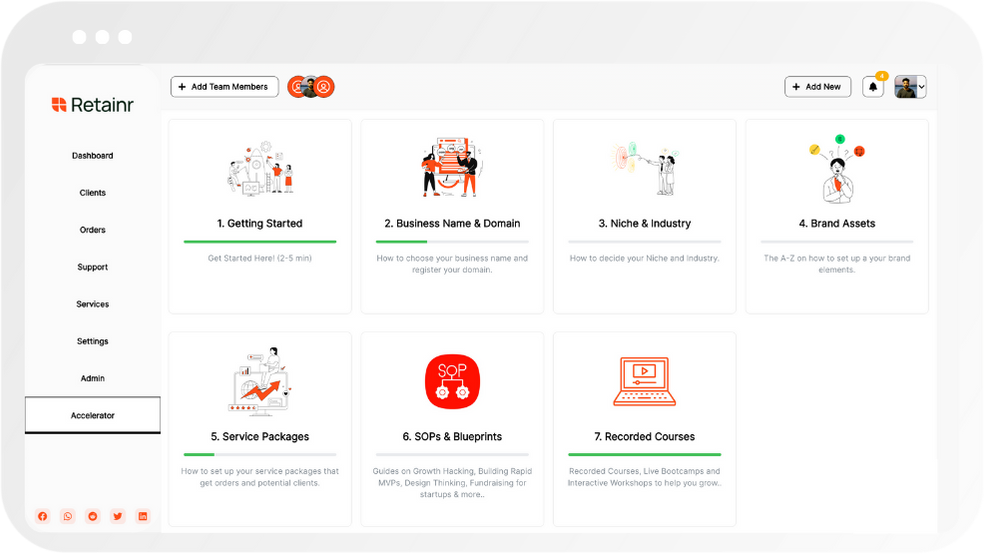
Remote Work Support: Implementing Effective Communication Tools
Build with Retainr
Sell your products and services, manage clients, orders, payments, automate your client onboarding and management with your own branded web application.
Get Started1. What are some effective communication tools for remote work support?
Communication Tools for Remote Work Support
Remote work support requires unique strategies and effective communication tools to ensure a conducive and productive work environment. With so many individuals working from home these days, companies must invest in efficient digital communication platforms. Several tools have proven effective for this role, and these include:
- Video Conferencing Tools - like Zoom, Microsoft Teams, and Google Meet. They facilitate group meetings, one-on-one communication, and presentations.
- Instant Messaging Apps - Slack, Skype, and Google Hangouts offer real time interaction, making communication seamless and instant.
- Collaboration Tools - like Trello, Basecamp, and Asana that aid in project management by keeping track of tasks, deadlines, and progress.
- Email - Still a reliable and formal way of communication, with tools such as Outlook and Gmail.
Comparison of Communication Tools
Each tool has its unique characteristics that determine how well it fits into the needs of a specific organization. The following table summarizes the features of some of these tools:
| Tool | Advantages | Disadvantages |
|---|---|---|
| Zoom | High-quality video and audio, screen sharing, and recording features. | Requires strong internet connection, time limit on meetings in the free version. |
| Slack | Direct and channel-based messaging, integration with other tools, and file sharing. | Limited search history and storage in the free version. |
| Trello | Intuitive interface, task assignment, deadline setting, and progress tracking. | Limited features in free version, may not be best suited for complex projects. |
The Importance of Choosing the Right Tools
Adopting the right communication tools for remote work support is critical to an organization’s success. It fosters better collaboration among team members, reduces potential confusion, and improves overall productivity. Due to the various advantages and disadvantages associated with each tool, it’s vital to carefully evaluate the specific needs of the company before choosing the most suitable ones. Always remember, access to a variety of effective communication tools and using them correctly are necessary to manage remote teams effectively.
2. How do you implement effective communication tools for remote work?
1. Identifying Suitable Communication Tools
Implementing effective communication tools for remote work begins with selecting the right tools. This primarily depends on the specific requirements of the business and the tasks that need to be accomplished. Some popular communication tools include Slack, Zoom, and Microsoft Teams, which can be used for instant messaging, video conferencing, and file sharing, respectively. Ease of use and integration capabilities with other tools should also be considered while making a choice.
- Slack: Ideal for instant messaging, integrates well with other tools
- Zoom: Offers high-quality video conferencing
- Microsoft Teams: Excellent for collaboration and file sharing
2. Creating a Communication Protocol
Once you have selected your communication tools, it's critical to establish a communication protocol. This should govern how, when, and why these tools should be used. Guidelines should also be given on the type of content that can be shared and how to maintain professionalism and courtesy while communicating.
| Communication Tool | Usage Guidelines |
|---|---|
| Slack | Used for daily updates and quick discussions |
| Zoom | Used for team meetings, presentations, and brainstorming sessions |
| Microsoft Teams | Used for project collaborations, document sharing, and updates |
3. Training for Team Members
Once the tools and guidelines are established, you need to ensure that all team members can use these tools effectively. In-depth training sessions about each tool’s features, etiquette to be followed, and troubleshooting methods can be conducted. Refresher training at intervals are equally important to keep up with any updates or changes
- Initial in-depth training on each tool units
- Thorough practice sessions for hands-on experience
- Periodic refresher sessions to stay updated
3. What challenges are commonly experienced when implementing communication tools in remote work settings?
Technical Challenges in Implementing Communication Tools
When implementing communication tools in remote work settings, various challenges are commonly experienced. Among them are:
- Reliability and Connectivity Issues: If the communication tool is not reliable or if employees are experiencing internet connectivity issues, it can disrupt workflow and hinder productivity.
- Compatibility with Devices: Not all communication tools are compatible across all devices, which can be especially problematic if employees are using different types of devices.
- Data Security: Ensuring the security of data transmitted through these tools can be a significant concern, particularly with the increase in cybersecurity threats.
Challenges from the Employee's Perspective
Apart from technical challenges, implementing communication tools also poses a challenge for the employees who need to use them. Some of the most common issues include:
- Adaptability: Employees may find it difficult to adapt to the new tool, especially if they are accustomed to traditional methods of communication.
- Training and Learning Curve: Some communication tools may be complex to use, and employees may need detailed training to fully understand how to use them effectively.
- Digitization of Interactions: Some employees struggle with the complete digitization of interactions, which can often lead to miscommunication or misunderstandings.
Common Challenges Displayed in a Table Format
| Areas | Challenges |
|---|---|
| Technical | Reliability and Connectivity Issues, Compatibility with Devices, Data Security. |
| Employee's Perspective | Adaptability, Training and Learning Curve, Digitization of Interactions. |
4. Can effective communication tools improve productivity in remote work?
How Effective Communication Tools Improve Productivity
Effective communication tools are integral to increasing productivity in a remote working environment. The right tools can streamline work processes, reduce misunderstandings, and ultimately enhance performance. This is even more important in a remote work setting where timely communication is crucial.
- Streamlined Work Processes: Tools such as task management applications and collaborative software allow team members interaction in real time, making it easier to manage projects and tasks. This benefit extends to scheduling meetings, assigning tasks, and keeping track of progress.
- Reduced Misunderstandings: Communication tools that include features for file sharing, screen sharing, instant messaging, and video conferencing help ensure that all team members are on the same page, thus reducing the potential for misunderstandings.
- Enhanced Performance: When communication is effective, performance is usually high. This is because team members can easily discuss tasks, brainstorm solutions, and provide timely feedback.
Impact of Effective Communication Tools on Productivity Metrics
A look at the numbers can give a clearer picture of how effective communication tools can improve productivity in remote work. Below is a simplified tabulation showing the potential impact of these tools on various productivity metrics.
| Productivity Metric | Without Communication Tools | With Communication Tools |
|---|---|---|
| Task Completion Time | High | Low |
| Task Error Rate | High | Low |
| Employee Satisfaction | Low | High |
From the table, it is evident that using effective communication tools can drastically reduce the time it takes to complete tasks, lower error rates, and enhance employee satisfaction, ultimately taking productivity to new heights.
5. How do you ensure secure communication while working remotely?
Implementing Secure Communication Tools
Ensuring secure communication while working remotely requires the use of robust mechanisms that deter unauthorized access and protect data integrity. First, it's necessary to utilize encrypted communication platforms. Technologies such as Transport Layer Security (TLS) encryption can secure data in transit, keeping sensitive information confidential from potential attackers.
- VPN (Virtual Private Network): A VPN provides a secure pipeline for data transference. It hides the IP addresses of devices and encrypts data making it unreadable to unauthorized parties.
- End-to-End Encryption: Most messaging platforms offer end-to-end encryption where only the sender and recipient can read a message, keeping it safe from third-party intrusion.
- Multi-Factor Authentication (MFA): MFA enhances security by requiring employees to provide multiple credentials for verification before granting access to information.
- Security Training: Regularly updating employees about possible risks and teaching them how to identify and prevent potential threats is another crucial step towards secure communication.
Here is an illustration of how these tools work together to provide a conflict-free remote working experience:
| Tool | What It Does | Benefit |
|---|---|---|
| VPN | Sets up a secure 'tunnel' for data transmission | Keeps the IP address anonymous, and makes data unreadable |
| End-to-End Encryption | Encrypts messages | Only sender and receiver can read the message |
| Multi-Factor Authentication | Requires multiple identity confirmations | Prevents unauthorized access |
| Security Training | Teaches employees about security measures | Minimizes the risk of security breaches due to ignorance |
6. How can I train my team to use these communication tools effectively?
Importance of Training for Effective Use of Communication Tools
Ensuring your team is well-versed in using communication tools is crucial for productive remote work. This can be achieved with focused training sessions. The first step is to offer comprehensive learning materials such as user guides, video tutorials or webinars, specifically related to the communication tools your company uses. This should include detailed instructions on how to use the software's features, as well as etiquette and best practices for professional communication in a remote environment.
Training Techniques and Platforms
Next, create a structured training plan. Consider employing a combination of the following methods:
- Live training sessions through video conferencing. This is interactive and gives employees the opportunity to ask questions in real-time.
- One-on-one training for those who need additional assistance.
- Peer coaching, where staff who are proficient with the tool train others.
- Self-paced online courses and webinars.
Use dedicated training platforms, such as TalentLMS or Docebo, that can track each team member's progress. Be sure to offer support and resources for ongoing learning and improvement.
Assessing Training Effectiveness
Finally, evaluate the effectiveness of your training program by monitoring adoption rates of the communication tools as well as feedback from employees. A simple table showing the results can be useful:
| Team Member | Completed Training (Y/N) | Comfort Level (1-5) | Feedback |
|---|---|---|---|
| John Doe | Y | 5 | Found the video tutorials extremely helpful |
| Jane Smith | N | 3 | Preferred live training sessions |
If there are members who are still struggling, offer additional training or assistance to ensure all team members are comfortable using the tools and can communicate effectively.
7. What are some tips for maintaining good communication in a remote team?
Tips for Good Communication in a Remote Team
Effective communication is the backbone of any remote team. It shapes the foundation for trust, cooperation, and productivity. Here are some key tips to consider:
- Use appropriate tools: Given a plethora of communication tools available, pick the ones that best meet your team's needs. Ensure they are user-friendly, reliable, and feature-rich. Tools like Slack, Microsoft Teams, or Google Meet are common choices.
- Set clear expectations: Ensure everyone is on the same page regarding the mode of communication and response timeframes. It can reduce confusion and miscommunications.
- Balance synchronicity: While real-time (synchronous) communication is essential, do not neglect the use of asynchronous communication, such as emails or shared documents, to allow team members in different time zones to contribute.
- Promote Open Communication: Encourage team members to express their thoughts, ideas, and concerns freely. This will foster a healthy dialogue and strong team rapport.
Establish Regular Check-Ins
Regular team meetings or check-ins are crucial for maintaining connection and ensuring everyone remains aligned with the goals. Here's how to make them effective:
- Establish Routine: Scheduled recurring meetings so they become a routine. This makes it easier for everyone to arrange their work schedules accordingly.
- Prep in Advance: Ask team members to prepare their updates or ideas prior to the meeting. This can save time and make meetings more productive.
- Keep it Engaging: Use tools for virtual whiteboarding, polling, or brainstorming to keep the engagement level high.
- Follow-up Action: Assign someone to document the discussions and decisions, and share meeting notes across the team for accountability.
Role of Effective Communication
| Roles | Responsibilities |
|---|---|
| Team Leader | Keep the team updated with important news, motivate and guide the team, and provide clear feedback. |
| Team Members | Stay proactive in communication, share challenges or issues promptly, and collaborate actively with other team members. |
| HR / Support Staff | Provide regular training on communication tools, organize team building activities, and address personal concerns or issues. |
8. How can the choice of communication tools affect a remote team's collaboration?
Effect of Communication Tools on Collaboration
Communication constitutes the cornerstone of collaboration specifically in a remote work setting. The choice of communication tools determines the ease of information exchange, the efficiency of collaboration, and the overall productivity of the team. First, let's look at how these tools impact team collaboration:
- Real-Time Communication: Tools like Zoom or Google Meet that support real-time communication enable team members to have instant interactions, useful for meetings or brainstorming sessions.
- Asynchronous Communication: On the other hand, tools like email or Slack that support asynchronous communication let team members communicate flexibly in different time zones and their preferred working times.
- Task Management Tools: Finally, tools like Trello or Asana are handy in tracking the team's tasks and progress. They help ensure that everyone is in sync and no task is left unattended.
Choosing the Right Communication Tools
Choosing the right communication tools is thus vital. A perfect balance of real-time and asynchronous communication tools along with effective task management systems composes a successful collaboration environment. Here's a simple guide on what to consider when selecting these tools:
| Consideration | Explanation |
|---|---|
| User-friendly | The tool should be easy to use to eliminate learning curves and ensure efficient usage. |
| Relevant Features | The tool should possess all necessary features demanded by the nature of your team's work. |
| Cost-effectiveness | The cost of the tool should be justified by its value, which can be determined by its benefits to your team's efficiency and productivity. |
Impact on Team Collaboration
Ultimately, with the right choice of communication tools, a remote team's collaboration can thrive. Real-time interaction channels foster connectivity, while asynchronous tools guard flexibility. Task management systems streamline workflows and keep everyone on the same page regardless of their location. Remember, the goal is to create a communication environment that supports your team's unique needs and maximizes productivity.
9. Are there any specific features to look for when choosing a communication tool for remote work?
Crucial Features to Consider In Communication Tools for Remote Work
When selecting a communication tool for remote work, some specific features enhance productivity, foster seamless collaboration, and ensure smooth operations. These features include:
- Reliability: The tool should be regularly available, with minimal downtime, to ensure uninterrupted communication.
- Real-time Communication: Look for features like instant messaging and video conferencing that facilitate instantaneous discussions.
- File sharing capability: The ability to share documents and files is essential in fostering collaboration among remote teams.
- Security: The communication tool must have robust security measures to protect sensitive information.
- User-friendliness: A user-friendly interface enhances the ease of use, which is crucial for promoting productivity among remote teams.
- Integration: The tool should integrate with other commonly used work tools to enhance work processes.
Comparative Analysis of Communication Tools for Remote Work
Here is a comparative analysis of some popular communication tools for remote work considering the above-mentioned features:
| Communication Tool | Reliability | Real-time Communication | File Sharing | Security | User-friendliness | Integration |
|---|---|---|---|---|---|---|
| Slack | High | Yes | Yes | High | High | Yes |
| Zoom | High | Yes | No | High | High | Yes |
| Microsoft Teams | High | Yes | Yes | High | High | Yes |
Concluding Remarks on Choosing Communication Tools for Remote Work
In conclusion, selecting the right communication tool for remote work requires a careful analysis of the tool’s features in line with the team’s operational needs. Ensure that the chosen tool fosters real-time communication, document sharing, and is user-friendly, reliable, secure, and supports integration with other work tools. Your tool of choice should add to your team’s convenience and enhance productivity.
10. How can you troubleshoot issues in communication tools while working remotely?
Troubleshooting Steps for Communication Tools
Troubleshooting issues with communication tools while working remotely can be challenging, but with the right strategies, it can be done effectively. Here are some steps to follow:
- Check Your Connection: Ensure you have a stable internet connection. Most communication tool issues are caused by poor connectivity. It's advisable to check whether the issue persists on different networks.
- Update the Tool: Outdated versions of communication tools may lead to functionality problems. Keeping your tools updated to the latest version can solve this.
- Restart the Application: Sometimes, merely restarting the communication tool can solve the problem. If the issue persists, consider rebooting your device.
- Clear Cache: Temporary files or cache may cause the application to malfunction. Regularly clearing your cache may provide a solution.
- Contact Customer Support: If the problem persists, contact the customer support of the communication tool. They can provide more personalized advice.
Documentation Details
Ensure to document all troubleshooting steps as it can prove valuable for future reference. Here's a simple example of how you can record your troubleshooting process.
| Date | Issue | Steps Taken | Result |
|---|---|---|---|
| 15/03/2022 | Audio issue on Zoom | Checked Audio Settings, Restarted Application | Resolved |
| 17/03/2022 | Connectivity problem on Slack | Checked Internet connection, Cleared Cache | Pending |
Consulting a Specialist
If the problem remains unresolved following these steps, you may need to consult a specialist. Communication problems may be due to:
- Software Issues: The application may have bugs or issues with your specific device or operating system.
- Hardware Issues: If your device's hardware, such as microphone or speakers, is faulty, it may be causing the issue.
- Network Issues: The problem could be caused by network configurations or restrictions from your Internet Service Provider.
Conclusion
How to Implement Effective Communication Tools for Remote Work Support?
In the current business landscape, more and more companies are transitioning to remote work models. However, this shift calls for effective and seamless communication among team members, regardless of their location. Using robust communication tools can significantly enhance productivity and collaboration, making remote work support more efficient.
Introducing Retainr.io: Revolutionize your Remote Work Communication
One such tool that makes remote team management a breeze is Retainr.io. This platform offers a comprehensive range of features that allow businesses to sell, manage clients, orders, and payments through their own branded application. With Retainr.io, you can maintain seamless communication and keep all stakeholders updated in real-time.
Key Features of Retainr.io to Amplify your Remote Work Experience
Retainr.io helps businesses streamline their operations and manage their remote workforce more effectively. It provides tools for task assignment and follow-up, secure messaging, real-time updates, and an array of other functionalities that keep your business operations running smoothly. Plus, with its easy-to-use interface, Retainr.io makes remote team management hassle-free and efficient.
Transform your Business with Retainr.io
No more juggling between different apps for different tasks - use Retainr.io to maintain consistent communication, collaborate with your team, and conduct business transactions, all in one place. Enjoy the power of effective communication and successful management of remote teams with Retainr.io. Ready to revolutionize your remote work experience? Visit www.retainr.io today.
Boost Your Agency Growth
with Retainr Accelerator
Uncover secrets, strategies, and exclusive blueprints to take your agency's growth to the next level — from marketing insights to effective presentations and leveraging technology.

SOPs, Cheatsheets & Blueprints
Leverage 50+ SOPs (valued over $10K) offering practical guides, scripts, tools, hacks, templates, and cheat sheets to fast-track your startup's growth.
Connect with fellow entrepreneurs, share experiences, and get expert insights within our exclusive Facebook community.
.jpg)

Join a thriving community of growth hackers. Network, collaborate, and learn from like-minded entrepreneurs on a lifelong journey to success.

Gain expertise with recorded Courses, Live Bootcamps and interactive Workshops on topics like growth hacking, copywriting, no-code funnel building, performance marketing and more, taught by seasoned coaches & industry experts.

.jpg)

.jpeg)


